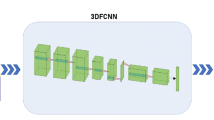Abstract
This paper presents a method for human action recognition from depth sequences captured by the depth camera. The main idea of the method is the action mapping image classification via convolutional neural network (CNN) based approach. Firstly, we project the raw frames onto three orthogonal Cartesian planes and stack the results into three still images (corresponding to the front, side, and top views) to form the Depth Motion Maps (DMMs). Secondly, Local Ternary Pattern (LTP) is introduced as an image filter for DMMs, thus to improve the distinguishability of similar actions. Finally, we apply CNN to action recognition by classifying corresponding LTP-encoded images. Experimental results on the popular and challenging benchmark MSR-Action 3D and MSR-Gesture dataset show the effectiveness of the presented method and meet real-time action recognition task requirements.







Similar content being viewed by others
References
Aggarwal JK, Xia L (2014) Human activity recognition from 3D data: a review. Pattern Recogn Lett 48(1):70–80
Chen C, Jafari R, Kehtarnavaz N (2015) Action recognition from depth sequences using depth motion maps-based local binary patterns. In: IEEE Winter Conference on Applications of Computer Vision. IEEE Computer Society, Hawaii, p 1092–1099
Chen C, Hou Z, Zhang B, Jiang J, Yang Y (2015) Gradient local auto-correlations and extreme learning machine for depth-based activity recognition. In: 11th international symposium on Visual Computing (ISVC'15). Springer International Publishing, Las Vegas, p 613-623
Chen C, Liu K, Kehtarnavaz N (2016) Real-time human action recognition based on depth motion maps. J Real-Time Image Proc 12(1):155–163
Guo P, Miao Z, Shen Y et al (2014) Continuous human action recognition in real time. Multimed Tools Appl 68(3):827–844
Hattori H, Lee N, Boddeti VN et al (2018) Synthesizing a scene-specific pedestrian detector and pose estimator for static video surveillance. Int J Comput Vis 126(9):1027–1044
He K, Zhang X, Ren S, Sun J (2016) Deep residual learning for image recognition. In: Computer Vision and Pattern Recognition. IEEE Computer Society, LAS Vegas, p 770-778
Junsong Y, Ying W, Zicheng L, Jiang W (2012) Mining action let ensemble for action recognition with depth cameras. In: Computer Vision and Pattern Recognition (CVPR). IEEE Computer Society, Providence, Rhode Island, p 1290–1297
Krizhevsky A, Sutskever I, Hinton GE (2012). ImageNet classification with deep convolutional neural networks. In: International Conference on Neural Information Processing Systems. Curran Associates Inc, Doha, p 1097-1105
Kurakin A, Zhang Z, Liu Z (2012) A real time system for dynamic hand gesture recognition with a depth sensor. In: European Signal Processing Conference. IEEE. Bucharest, Romania, p 1975–1979
Laraba S, Brahimi M, Tilmanne J et al (2017) 3D skeleton-based action recognition by representing motion capture sequences as 2D-RGB images. Comput Anima Virt W 28(3-4):1–11
Li X, Li J (2013) Lpt optimization algorithm in the nuclear environment image monitoring. J Softw 8(3):659–665
Li W, Zhang Z, Liu Z (2010) Action recognition based on a bag of 3D points. In: Computer Vision and Pattern Recognition Workshops. IEEE Computer Society, San Francisco, p 9-14
Oreifej O, Liu Z (2013) HON4D: histogram of oriented 4D normals for activity recognition from depth sequences. In: Computer Vision and Pattern Recognition. IEEE Computer Society, Portland, p 716–723
Reily B, Han F, Parker LE et al (2018) Skeleton-based bio-inspired human activity prediction for real-time human–robot interaction. Auton Robot 42(4):1281–1298
Shen Z, Liu Z, Li J, et al. (2017) DSOD: Learning deeply supervised object detectors from scratch. In: IEEE International Conference on Computer Vision, ICCV, Venis Italy, p 1937–1945
Simonyan K, Zisserman A (2015) Very deep convolutional networks for large-scale image recognition. In: International Conference on Learning Representations. ICLR, San Diego, p 1-14
Tan X, Triggs B (2010) Enhanced local texture feature sets for face recognition under difficult lighting conditions. IEEE Trans Image Process 19(6):1635–1650
Wang J, Liu Z, Chorowski J, Chen Z, Wu Y (2012) Robust 3d action recognition with random occupancy patterns. In: European Conference on Computer Vision. Springer-Verlag, Florence, p 872–885
Wang P, Li W, Gao Z, Tang C, Zhang J, Ogunbona P (2015) ConvNets-Based Action Recognition from Depth Maps through Virtual Cameras and Pseudo coloring. In: ACM International Conference on Multimedia. ACM, Brisbane, p 1119-1122
Wang P, Li W, Gao Z, Zhang J, Tang C, Ogunbona P (2016) Action recognition from depth maps using deep convolutional neural networks. IEEE Trans Human-Mach Syst 46(4):498–509
Xia L, Aggarwal JK (2013) Spatio-temporal depth cuboid similarity feature for activity recognition using depth camera. In: Computer Vision and Pattern Recognition. IEEE Computer Society, Portland, p 2834-2841
Yang X, Tian YL (2012) Eigen joints-based action recognition using naïve-bayes-nearest-neighbor. In: Computer Vision and Pattern Recognition Workshops. IEEE Computer Society, Providence, Rhode Island, p 14–19
Yang R, Yang R (2015) DMM-pyramid based deep architectures for action recognition with depth cameras. In: Asian Conference on Computer Vision. Springer International Publishing, Singapore, p 37–49
Yang X, Zhang C, Tian Y (2012) Recognizing actions using depth motion maps-based histograms of oriented gradients. In: Proceedings of ACM International Conference on Multimedia. ACM, Nara, Japan, p 1057-1060
Yang J, Wang Y, Lv Z et al (2018) Interaction with three-dimensional gesture and character input in virtual reality: recognizing gestures in different directions and improving user input. IEEE Consum Electro 7(2):64–72
Zanfir M, Leordeanu M, Sminchisescu C (2013) The moving pose: an efficient 3D kinematics descriptor for low-latency action recognition and detection. In: IEEE International Conference on Computer Vision. IEEE Computer Society, Sydney, p 2752–2759
Acknowledgments
The authors thank the anonymous reviewers for valuable comments. This work is mainly supported by grants from Zhejiang Provincial Top Key Discipline of Computer Software and Theory, National Natural Science Foundation of China (No. 61170109, 61672467), and National Science Foundation of Zhejiang Province (No. 2015C31095), China.
Author information
Authors and Affiliations
Corresponding author
Additional information
Publisher’s note
Springer Nature remains neutral with regard to jurisdictional claims in published maps and institutional affiliations.
Rights and permissions
About this article
Cite this article
Li, Z., Zheng, Z., Lin, F. et al. Action recognition from depth sequence using depth motion maps-based local ternary patterns and CNN. Multimed Tools Appl 78, 19587–19601 (2019). https://doi.org/10.1007/s11042-019-7356-3
Received:
Revised:
Accepted:
Published:
Issue Date:
DOI: https://doi.org/10.1007/s11042-019-7356-3




